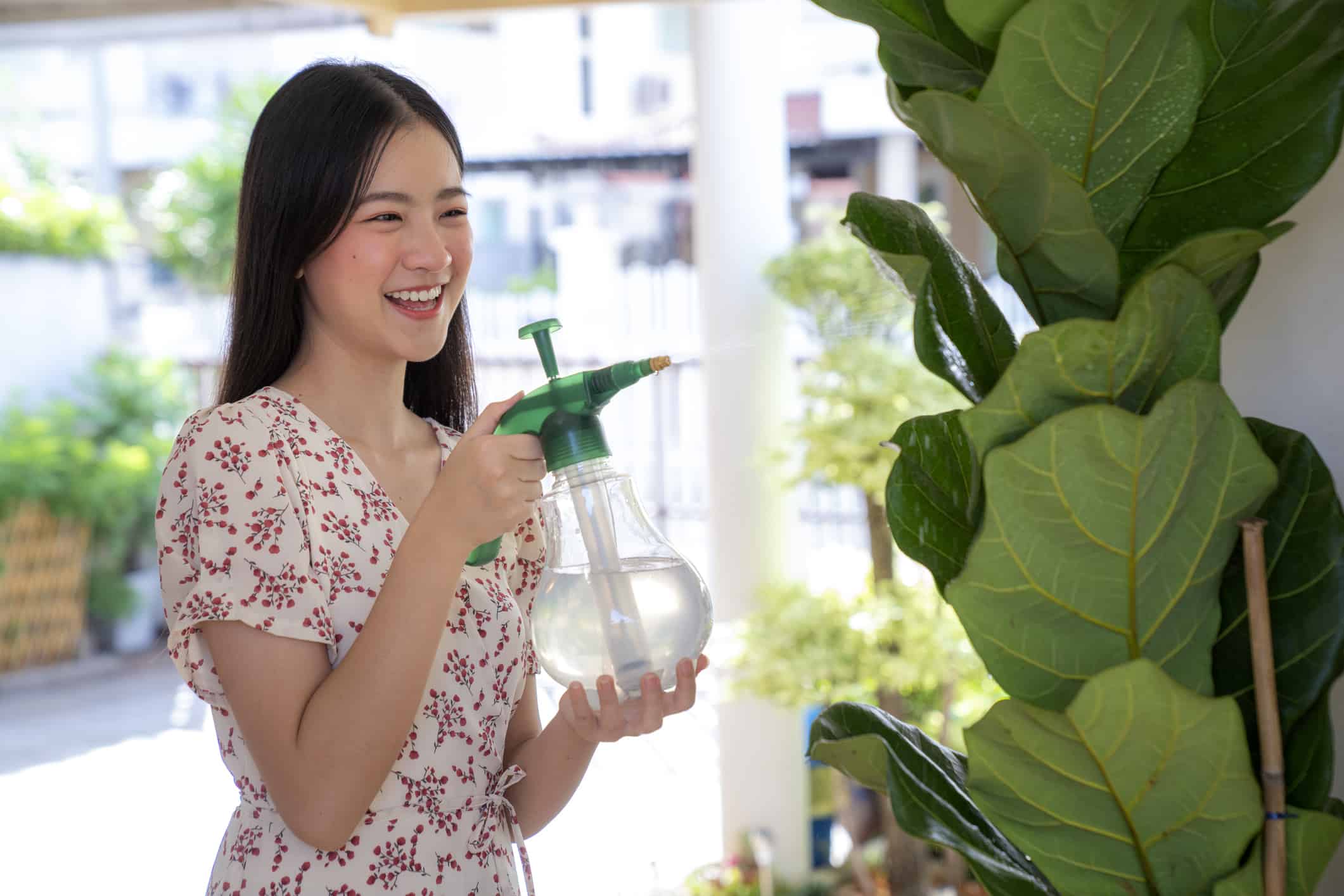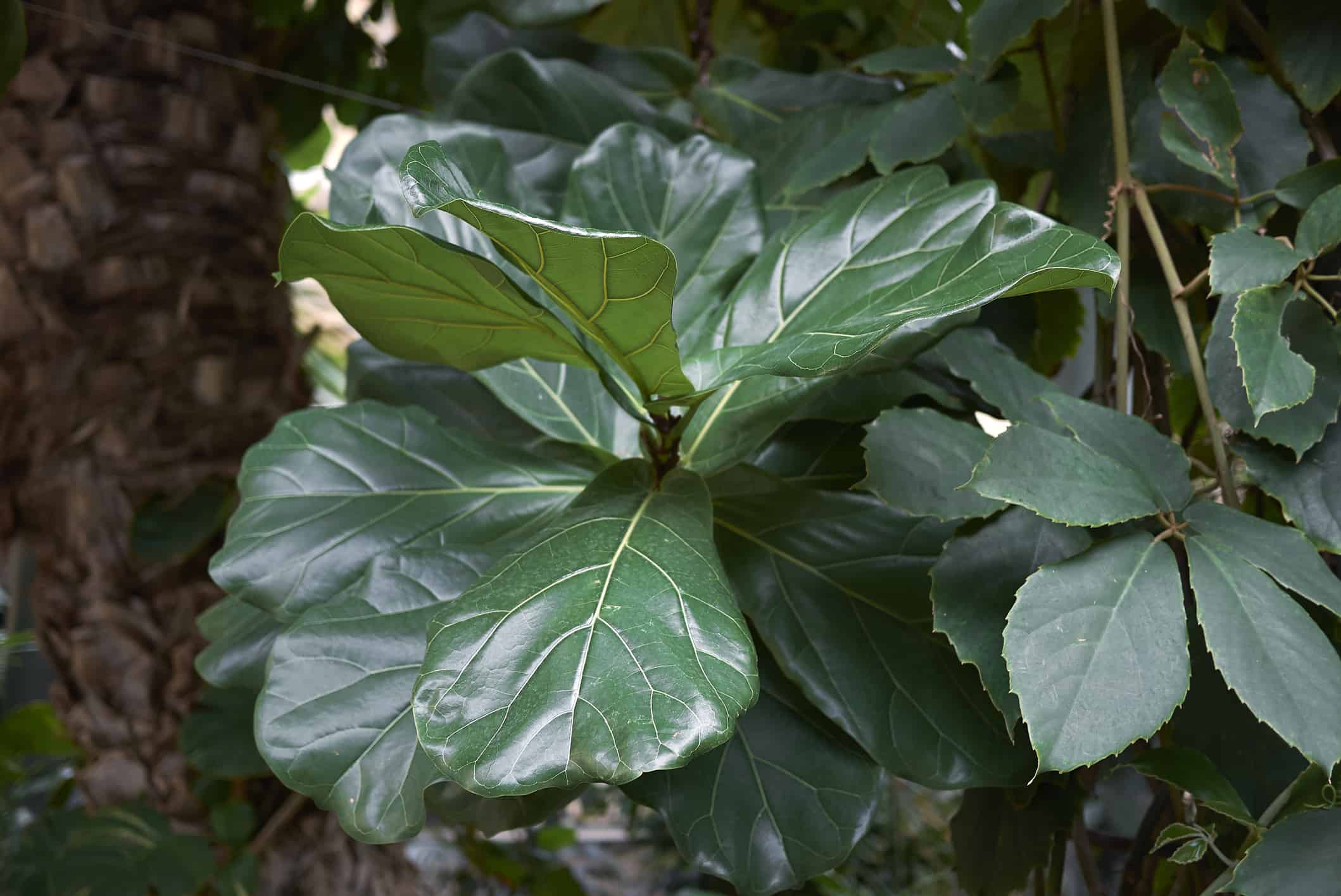Ficus lyrata is a stunning plant with huge green leaves shaped like a violin, hence its name, fiddle leaf fig. Like all plants, they need water to grow strong and healthy, but how much they need is a touch confusing. The truth is, it really depends on the temperature, season, and plant size. Here’s how often to water your fiddle leaf fig and other watering tips to keep a fiddler in tip-top shape.
How Often to Water Your Fiddle Leaf Fig
Let’s start with an indoor fiddler. Because they are tropical African rainforest plants, most people have to grow them indoors. This puts it entirely at your mercy and dependent on your memory skills!
Indoor Fiddle Leaf Fig
A fiddler shouldn’t need more than a weekly watering if it’s indoors because consistently damp soil causes root rot. Some folk suggest watering your fig each Friday, and this can work well if you’re forgetful, but the touch-and-test method is the most effective. More on that below.
Outdoors Fiddle Leaf Fig
How often you should water an outdoor fiddle leaf fig depends on the weather. Ground-grown fiddlers won’t need much if it’s rained, but container-grown fiddlers will because their roots can’t access rain-wet soil.
Water your potted fiddle leaf fig several times a week in hot spells and drought. Ground growers are less intensive; a once-a-week soak should do the trick, but all pots have different requirements. For example, a large plant in a small pot will need more frequent watering than a large container.
However, the only way to tell for sure if a fiddle leaf fig needs water is by using the touch and test method.
How to Check If Your Fiddle Leaf Fig Needs Water
Indoors, the best method is touch and test. Push your finger into the soil. If the top inch or so of soil is dry, it’s time to water. Testing first keeps root rot at bay.
Fiddle leaf fig trees planted in the ground generally need less attention because the rain keeps them hydrated, although it’s worth saying that light rain doesn’t count because it dries off before reaching any roots. In hot spells or drought conditions, give your outdoor fiddler a can of water once or twice a week, more if the touch and test method indicates the soil is dry. If it’s a newbie plant, daily water is necessary until it’s established. You’ll know it’s established when new growth appears.
Container-grown outdoor fiddlers need lots of water in the dry growing months. Much like a houseplant, they’re at the mercy of your watering can. Wind and sunshine rapidly dry out containers, so check them every few days in hot weather by touch-testing the soil. If it’s dry on top, it’s time to water.
Generally, plants need more water in the warm months and less in the cool months. If you live in a hot Zone such as USDA Zones 10-11, you’ll have to water more frequently than Zones 8-9.

An indoor fiddle leaf fig shouldn’t need more than weekly watering.
©Kowit Phatipreechakul/Shutterstock.com
How to Water Your Fiddle Leaf Fig Indoors
If the top is dry down an inch or so, it’s time for a drink. Take the liner pot out of the display pot and soak it in a sink of water for several hours. Once the soil is saturated, let it drain off excess water on the draining board before replacing it.
If the fiddler is too big to move (lucky you!), add a cup of water when the topsoil is dry.
How to Water It Outdoors
If your fiddle leaf fig is container-grown and small enough to move, the best method is soaking it in a bucket of water. If not, water it thoroughly until water runs from the base. If you do this early morning or late evening, there’s less evaporation and water waste.
8 Signs a Fiddle Leaf Fig Needs Water More Often
With the best will in the world and plenty of touching and testing, some fiddle leaf figs need more water. Here are a few signs you need to increase the liquid intake.
Wilting: Without sufficient water, a fiddle leaf fig’s leaves will sag and wilt. Conversely, this can indicate overwatering, so touch tests the compost first.
Lightweight pot: Water is heavy! A fully hydrated fiddler with damp soil feels weighty. Light pots indicate a lack of water. Lightweight dehydrated pots may blow over outdoors.
Poor growth: Fiddlers usually grow at least a foot each year, maxing out at ten feet indoors. If yours has much less growth, try upping its water.
Dull leaves and stems: Fiddle leaf figs are shiny, glossy, and gorgeous. Dull, rough leaves indicate inadequate water or fertilizer.
Pale or dark leaves: Mid to deep green foliage is the standard. Dehydrated fiddler leaves lose their color.
Brown tips: Brown tips are a sign of over or under-watering on most plants. Check the soil to figure out which way yours has gone.
Curled foliage: Fiddler leaves are large, grow upwards, and have lots of crinkles, but if the tips start to curl up, this can mean they need more water.
Mildew and mold: Dehydrated plants develop mildew and mold because they are weak and unable to fight off fungal spores that float around in the environment.

Fiddle-leaf fig plants typically have mid to deep green foliage, but if they are dehydrated, fiddler leaves will lose their color.
©Jantanee Boonkhaw/Shutterstock.com
Fiddle Leaf Fig Watering Tips
So we’ve found out how often to water your fiddle leaf fig through the touch and test method, but here are extra watering tips to get your fiddler into really great shape.
Rainwater or Tap Water?
Rainwater is generally better than tap water for all types of plants because it doesn’t contain chlorine and has a lower pH, which won’t affect nutrient levels. In hard water areas, tap water can leave limescale deposits that can damage stems, foliage, and flowers.
However, tap water is better than no water, so go ahead and use it if you don’t have rainwater to hand.
What About Ice Cubes?
Ice cube watering isn’t effective. The volume of water is too little, and the coldness can shock figs, so they drop leaves.
Regular Misting
Fiddle leaf figs love misting because they are native to hot and steamy rainforests. Central heating and or air conditioning dries out their foliage, which can lead to brown spots.
Unless your fiddler is in a steamy bathroom, it’s a really good habit to mist its leaves once or twice a week to up humidity levels. You don’t need a special mister; a thoroughly washed kitchen or bathroom spray bottle is perfect.
As well as increasing humidity, regular misting removes foliage dust, which encourages photosynthesis and a really healthy plant.

Regular misting of your fiddle leaf fig plant increases humidity and helps to remove foliage dust.
©iStock.com/NeoPhoto
Water the Roots
Fiddle leaf figs take up water from their roots, so although gentle misting will up the humidity, it won’t help them drink. When you water a fiddler, soak the roots.
Water Thoroughly Less Often
Watering thoroughly less often is more effective than frequent dribbles. If you can soak your fiddle leaf fig for a few hours when the soil is drying out, that is more effective than pouring half a cup on the surface every few days. It might seem counterintuitive, but it lets water get to the deeper root tips and allows air on the root when it’s drying out. Roots need air as well as water.
Consider Soil Types
How often outdoor fiddle leaf figs need water is affected by soil type.
If your soil is rich, loamy, and moisture-retentive, then less water is needed than chalk or light sandy soil. To mitigate watering every day, bulk up soil around your fiddlers with compost, mulch, and well-rotted organic matter because this holds onto moisture and traps it around plant roots.

Fiddle leaf fig trees planted in the ground generally need less attention because the rain keeps them hydrated,
©iStock.com/seven75
Here’s How Often to Water Your Fiddle Leaf Fig
Let’s recap!
Indoor fiddle leaf figs need water when the top soil is beginning to dry out. Touch and test it by pushing a finger into the soil. If it feels dry up to an inch, it’s time to water. If it’s still damp, then hold off for a few days.
Test outdoor container-bound fiddlers the same way, and fiddle leaf fig trees in the ground are dependent on soil type and rainfall. It’s best to keep an eye on the weather and give them a good soaking during dry spells or drought.
If your fiddle leaf fig is discolored, wilting, mildewed, curling or browning at the tips, failing to grow, or the pot is blowing over, it’s time to give it a good drink.
The photo featured at the top of this post is © AngieYeoh/Shutterstock.com
Thank you for reading! Have some feedback for us? Contact the AZ Animals editorial team.






